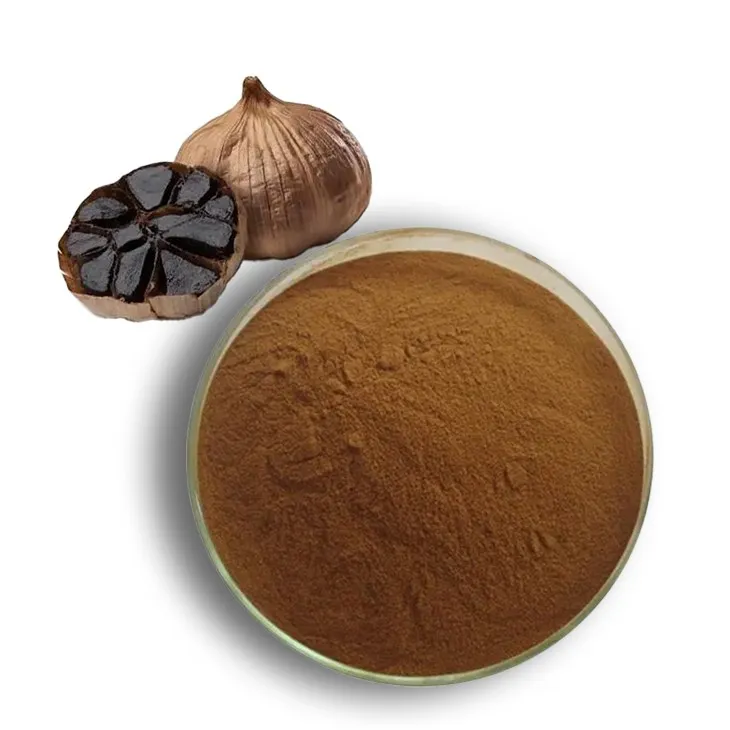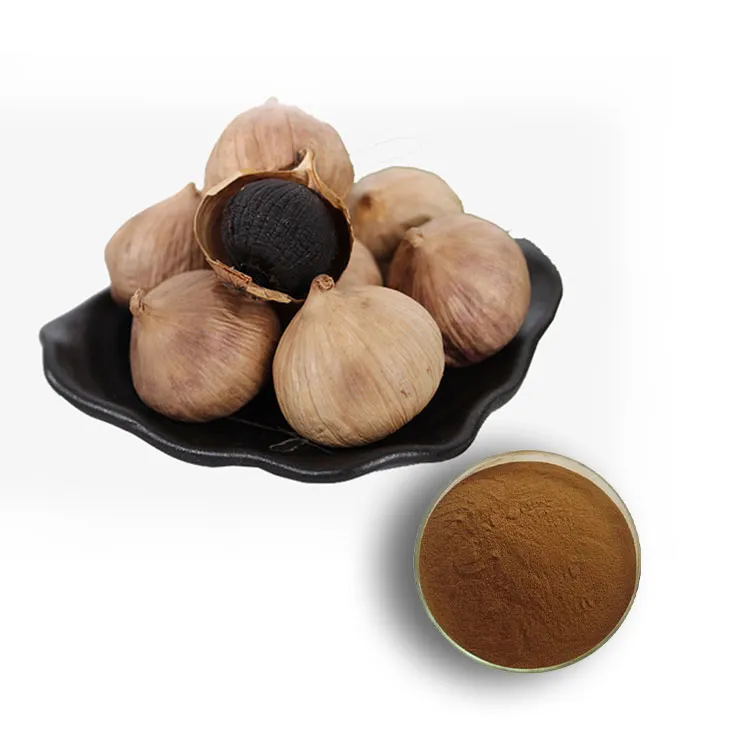- 0086-571-85302990
- sales@greenskybio.com
Extraction process of black garlic extract.
2024-11-27

1. Introduction to Black Garlic
Black garlic is a unique food product that has gained popularity in recent years due to its potential health benefits. It is created through a carefully controlled fermentation process of regular white garlic. During this fermentation, the chemical composition of the garlic undergoes significant changes. Regular garlic contains various compounds such as allicin, which is known for its antibacterial and antioxidant properties. However, through fermentation, black garlic develops a more complex profile of bioactive compounds, including higher levels of antioxidants, polyphenols, and S - allylcysteine.

2. Procurement of Well - Fermented Black Garlic
The first step in the extraction of black - garlic extract is to obtain high - quality, well - fermented black garlic. This is crucial as the quality of the final extract depends largely on the starting material. Black garlic can be sourced from various suppliers, but it is important to ensure that it has been fermented under proper conditions. The fermentation process typically takes several weeks, during which the garlic is kept at a specific temperature and humidity level. When procuring black garlic, factors such as its origin, the fermentation method used, and its overall appearance and aroma should be considered.

3. Preparation of Black Garlic for Extraction
3.1 Washing
Once the black garlic is obtained, it may need to be washed. This step is important to remove any dirt, debris, or surface contaminants that may be present on the garlic cloves. However, care should be taken not to over - wash the black garlic as it may cause the loss of some water - soluble compounds. Gentle washing with clean water is usually sufficient.3.2 Drying
After washing, if necessary, the black garlic should be dried. Drying helps to reduce the moisture content of the garlic, which can affect the extraction process. Excess moisture can dilute the solvents used in extraction and may also lead to the growth of microorganisms. The drying process can be carried out at a low temperature, either in an oven or under natural air - drying conditions, depending on the scale of production.
4. Mechanical Breakdown of Black Garlic
To facilitate extraction, the black garlic needs to be broken down into a more manageable form. Mechanical methods such as grinding are commonly used for this purpose. Grinding can be done using a mortar and pestle for small - scale extraction or a mechanical grinder for larger quantities. The goal is to reduce the black garlic into a fine powder or paste - like consistency. This increases the surface area of the black garlic, allowing for better contact with the extraction solvents and more efficient extraction of the desired compounds.
5. Selection of Solvents for Extraction
5.1 Ethanol - based Extraction
One of the most common solvents used for black - garlic extract extraction is ethanol. Ethanol is a good choice because it can effectively dissolve many of the bioactive substances present in black garlic, such as polyphenols and S - allylcysteine. It also has the advantage of being relatively safe, easy to handle, and can be easily removed from the extract through evaporation. The concentration of ethanol can vary depending on the specific requirements of the extraction. A typical concentration range is between 50% - 95% ethanol.5.2 Other Solvents
In addition to ethanol, other solvents can also be considered for black - garlic extract extraction. For example, water can be used as a solvent, especially if the focus is on extracting water - soluble compounds. However, water - based extraction may also extract a larger amount of unwanted substances. Organic solvents such as methanol, acetone, and ethyl acetate can also be used, but they may have some limitations in terms of safety, cost, and the need for more complex purification steps after extraction.6. The Extraction Process
6.1 Temperature Conditions
The extraction is carried out under specific temperature conditions. For ethanol - based extraction, a temperature range of usually 20 - 60°C is often used. The choice of temperature depends on the stability of the compounds to be extracted and the solubility characteristics of the solvent. Higher temperatures can generally increase the rate of extraction, but it may also cause the degradation of some heat - sensitive compounds.6.2 Time Considerations
The extraction time also plays an important role. It can range from a few hours to several days, depending on the nature of the black garlic, the solvent used, and the desired extraction efficiency. Longer extraction times may result in a more complete extraction of the compounds, but it may also increase the risk of extracting unwanted substances or causing the degradation of some compounds.6.3 Solvent - to - Sample Ratio
The ratio of the solvent to the black - garlic sample is another critical factor. A higher solvent - to - sample ratio generally leads to more efficient extraction as there is more solvent available to dissolve the compounds. However, a very high ratio may also be wasteful and may require more energy for solvent removal later. A typical solvent - to - sample ratio for black - garlic extract extraction can range from 5:1 to 20:1 (volume/weight).7. Processing the Extracted Mixture
7.1 Filtration
After the extraction process, the resulting mixture contains the black - garlic extract along with solid particles such as cell debris. Filtration is the first step to separate these large particles from the extract. Simple filtration using filter paper or a filter funnel can be used for small - scale extraction, while for larger - scale production, more advanced filtration systems such as vacuum filtration or membrane filtration may be required. Filtration helps to improve the clarity and purity of the extract.7.2 Evaporation or Distillation
Following filtration, the next step is to remove the solvent from the extract. Evaporation or distillation is commonly used for this purpose. Evaporation involves heating the extract - solvent mixture under controlled conditions to allow the solvent to evaporate, leaving behind the concentrated black - garlic extract. Distillation is a more complex process that can be used to separate the solvent from the extract more precisely, especially when dealing with solvents that have a relatively low boiling point or when a high - purity extract is required.8. Quality Control of the Black - Garlic Extract
Once the black - garlic extract has been obtained, it is important to perform quality control tests to ensure its safety and efficacy. Quality control measures may include tests for the presence and concentration of key bioactive compounds, such as polyphenols and S - allylcysteine. Microbiological tests should also be carried out to ensure that the extract is free from harmful microorganisms. Additionally, the physical and chemical properties of the extract, such as its pH, solubility, and appearance, should be evaluated. Any batch of black - garlic extract that does not meet the required quality standards should be rejected or re - processed.
9. Applications of Black - Garlic Extract
Black - garlic extract has a wide range of potential applications. In the food industry, it can be used as a natural flavor enhancer and preservative due to its rich flavor and antioxidant properties. In the pharmaceutical and nutraceutical industries, it is being investigated for its potential health benefits, such as anti - inflammatory, anti - cancer, and cardiovascular - protective effects. It can also be used in the cosmetic industry for its antioxidant and skin - nourishing properties, for example, in anti - aging creams and lotions.
10. Conclusion
The extraction process of black - garlic extract is a multi - step and complex process that requires careful attention to each stage. From the procurement of high - quality black garlic to the final quality control of the extract, every step plays a crucial role in obtaining a high - quality product. With the increasing interest in the health benefits and potential applications of black - garlic extract, continuous research and improvement in the extraction process are also necessary to meet the growing demand.
FAQ:
What are the main steps in the extraction process of Black Garlic Extract?
The main steps include procuring well - fermented black garlic, preparing it (such as washing and drying if needed), using mechanical methods like grinding, choosing a solvent (such as ethanol - based extraction) and carrying out the extraction under specific temperature, time and solvent - to - sample ratio conditions, and then processing the resulting mixture through filtration, evaporation or distillation to isolate and concentrate the extract.
Why is ethanol - based extraction common for Black Garlic Extract?
Ethanol - based extraction is common because it can effectively extract many of the bioactive substances present in black garlic.
What is the importance of proper fermentation in obtaining black garlic for extraction?
Proper fermentation is important as it enriches the regular garlic with various beneficial compounds, which are then available for extraction in the Black Garlic Extract process.
How is the quality of the final black - garlic extract ensured?
The quality of the final product is ensured through steps like proper preparation of the black garlic before extraction, using appropriate extraction conditions (temperature, time, solvent - to - sample ratio), and processing the resulting mixture after extraction by filtration, evaporation or distillation to remove impurities and concentrate the extract.
What role does grinding play in the extraction process of black garlic extract?
Grinding plays the role of breaking down the black garlic into a more manageable form, which makes it easier for the solvent to interact with the substances in the black garlic during the extraction process.
Related literature
- The Bioactive Compounds in Black Garlic and Their Extraction Methods"
- "Optimization of Black Garlic Extract Production: A Review"
- "Black Garlic Extract: Properties, Extraction and Potential Applications"
- ▶ Hesperidin
- ▶ citrus bioflavonoids
- ▶ plant extract
- ▶ lycopene
- ▶ Diosmin
- ▶ Grape seed extract
- ▶ Sea buckthorn Juice Powder
- ▶ Beetroot powder
- ▶ Hops Extract
- ▶ Artichoke Extract
- ▶ Reishi mushroom extract
- ▶ Astaxanthin
- ▶ Green Tea Extract
- ▶ Curcumin Extract
- ▶ Horse Chestnut Extract
- ▶ Other Problems
- ▶ Boswellia Serrata Extract
- ▶ Resveratrol Extract
- ▶ Marigold Extract
- ▶ Grape Leaf Extract
- ▶ blog3
- ▶ blog4
-
Nature's best β - carotene.
2024-11-27
-
Standard - process Coenzyme Q10.
2024-11-27
-
Bulk purchase of pomegranate extract.
2024-11-27
-
Extraction process of bilberry extract.
2024-11-27
-
Manufacturers of Euphrasia Extract.
2024-11-27
-
Chinese peppermint oil powder factories.
2024-11-27
-
Boswellia Serrata Extract
2024-11-27
-
Mulberry Extract
2024-11-27
-
Ginseng Root Extract
2024-11-27
-
Withania Somnifera Extract
2024-11-27
-
Sugarcane Extract
2024-11-27
-
Propolis Extract Powder
2024-11-27
-
Beetroot juice Powder
2024-11-27
-
Jujube Extract
2024-11-27
-
Eyebright Extract
2024-11-27
-
Reishi mushroom extract
2024-11-27





















